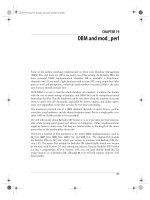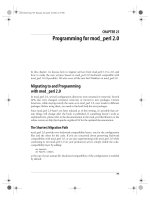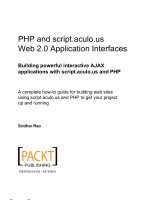Practical mod_perl-CHAPTER 24:Mod_perl 2.0: Installation and Configuration
Bạn đang xem bản rút gọn của tài liệu. Xem và tải ngay bản đầy đủ của tài liệu tại đây (675.69 KB, 24 trang )
This is the Title of the Book, eMatter Edition
Copyright © 2004 O’Reilly & Associates, Inc. All rights reserved.
685
Chapter 24
CHAPTER 24
mod_perl 2.0: Installation and
Configuration
Since Doug MacEachern introduced mod_perl 1.0
*
in 1996, he has had to tweak it
with every change in Apache and Perl, while maintaining compatibility with the
older versions. These rewrites have led to very complex source code, with hundreds
of
#ifdef
s and workarounds for various incompatibilities in older Perl and Apache
versions.
Apache 2.0, however, is based on a new threads design, requiring that mod_perl be
based on a thread-safe Perl interpreter. Perl 5.6.0 was the first Perl version to sup-
port internal thread-safety across multiple interpreters. Since Perl 5.6.0 and Apache
2.0 are the very minimum requirements for the newest version of mod_perl, back-
ward compatibility was no longer a concern, so this seemed like a good time to start
from scratch. mod_perl 2.0 was the result: a leaner, more efficient mod_perl that’s
streamlined for Apache 2.0.
mod_perl 2.0 includes a mechanism for building the Perl interface to the Apache API
automatically, allowing us to easily adjust mod_perl 2.0 to the ever-changing Apache
2.0 API during its development period. Another important feature is the
Apache::
Test
framework, which was originally developed for mod_perl 2.0 but then was
adopted by Apache 2.0 developers to test the core server features and third-party
modules. Moreover the tests written using the
Apache::Test
framework could be run
with Apache 1.0 and 2.0, assuming that both supported the same features.
Many other interesting changes have already happened to mod_perl in Version 2.0,
and more will be developed in the future. Some of these will be covered in this chap-
ter, and some you will discover on your own while reading mod_perl documentation.
At the time of this writing, mod_perl 2.0 is considered beta when used with the pre-
fork Multi-Processing Model module (MPM) and alpha when used with a threaded
* Here and in the rest of this and the next chapter we refer to the mod_perl 1.x series as mod_perl 1.0 and to
2.0.x as mod_perl 2.0 to keep things simple. Similarly, we call the Apache 1.3.x series Apache 1.3 and the 2.
0.x series Apache 2.0.
,ch24.25990 Page 685 Thursday, November 18, 2004 12:47 PM
This is the Title of the Book, eMatter Edition
Copyright © 2004 O’Reilly & Associates, Inc. All rights reserved.
686
|
Chapter 24: mod_perl 2.0: Installation and Configuration
MPM. It is likely that Perl 5.8.0+ will be required for mod_perl 2.0 to move past
alpha with threaded MPMs. Also, the Apache 2.0 API hasn’t yet been finalized, so
it’s possible that certain examples in this chapter may require modifications once
production versions of Apache 2.0 and mod_perl 2.0 are released.
In this chapter, we’ll first discuss the new features in Apache 2.0, Perl 5.6 and later,
and mod_perl 2.0 (in that order). Then we’ll cover the installation and configuration
of mod_perl 2.0. Details on the newfunctionality implemented in mod_perl 2.0 are
provided in Chapter 25.
What’s New in Apache 2.0
Whereas Apache 1.2 and 1.3 were based on the NCSA httpd code base, Apache 2.0
rewrote big chunks of the 1.3 code base, mainly to support numerous new features
and enhancements. Here are the most important new features:
Apache Portable Runtime (APR)
The APR presents a standard API for writing portable client and server applica-
tions, covering file I/O, logging, shared memory, threads, managing child pro-
cesses, and many other functionalities needed for developing the Apache core
and third-party modules in a portable and efficient way. One important effect is
that it significantly simplifies the code that uses the APR, making it much easier
to reviewand understand the Apache code, and increasing the number of
revealed bugs and contributed patches.
The APR uses the concept of memory pools, which significantly simplifies the
memory-management code and reduces the possibility of memory leaks (which
always haunt C programmers).
I/O filtering
Apache 2.0 allows multiple modules to filter both the request and the response.
Nowone module can pipe its output to another module as if it were being sent
directly from the TCP stream. The same mechanism works with the generated
response.
With I/O filtering in place, simple filters (e.g., data compression and decompres-
sion) can easily be implemented, and complex filters (e.g., SSL) can nowbe
implemented without needing to modify the the server code (unlike with Apache
1.3).
To make the filtering mechanism efficient and avoid unnecessary copying, the
bucket brigades model was used, as follows.
A bucket represents a chunk of data. Buckets linked together comprise a bri-
gade. Each bucket in a brigade can be modified, removed, and replaced with
another bucket. The goal is to minimize the data copying where possible. Buck-
ets come in different types: files, data blocks, end-of-stream indicators, pools,
etc. You don’t need to knowanything about the internal representation of a
bucket in order to manipulate it.
,ch24.25990 Page 686 Thursday, November 18, 2004 12:47 PM
This is the Title of the Book, eMatter Edition
Copyright © 2004 O’Reilly & Associates, Inc. All rights reserved.
What’s New in Apache 2.0
|
687
The stream of data is represented by bucket brigades. When a filter is called, it
gets passed the brigade that was the output of the previous filter. This brigade is
then manipulated by the filter (e.g., by modifying some buckets) and passed to
the next filter in the stack.
Figure 24-1 depicts an imaginary bucket brigade. The figure shows that after the
presented bucket brigade has passed through several filters, some buckets were
removed, some were modified, and some were added. Of course, the handler
that gets the brigade doesn’t knowthe history of the brigade; it can only see the
existing buckets in the brigade. We will see bucket brigades in use when discuss-
ing protocol handlers and filters.
Multi-Processing Model modules (MPMs)
In the previous Apache generation, the same code base was trying to manage
incoming requests for different platforms, which led to scalability problems on
certain (mostly non-Unix) platforms. This also led to an undesired complexity of
the code.
Apache 2.0 introduces the concept of MPMs, whose main responsibility is to map
the incoming requests to either threads, processes, or a threads/processes hybrid.
Nowit’s possible to write different processing modules specific to various plat-
forms. For example, Apache 2.0 on Windows is much more efficient and main-
tainable now, since it uses mpm_winnt, which deploys native Windows features.
Figure 24-1. Imaginary bucket brigade
Apache 2.0
Bucket brigades
Original buckets Removed buckets Added buckets
,ch24.25990 Page 687 Thursday, November 18, 2004 12:47 PM
This is the Title of the Book, eMatter Edition
Copyright © 2004 O’Reilly & Associates, Inc. All rights reserved.
688
|
Chapter 24: mod_perl 2.0: Installation and Configuration
Here is a partial list of the major MPMs available as of this writing:
prefork
The prefork MPM implements Apache 1.3’s preforking model, in which
each request is handled by a different forked child process.
worker
The worker MPM implements a hybrid multi-process/multi-threaded
approach based on the pthreads standard.
mpmt_os2, netware, winnt, and beos
These MPMs also implement the hybrid multi-process/multi-threaded
model, like worker, but unlike worker, each is based on the native OS thread
implementations, while worker uses the pthread library available on Unix.
On platforms that support more than one MPM, it’s possible to switch the used
MPMs as the need changes. For example, on Unix it’s possible to start with a
preforked module, then migrate to a more efficient threaded MPM as demand
grows and the code matures (assuming that the code base is capable of running
in the threaded environment).
New hook scheme
In Apache 2.0 it’s possible to dynamically register functions for each Apache
hook, with more than one function registered per hook. Moreover, when adding
newfunctions, you can specify where the newfunction should be added—for
example, a function can be inserted between two already registered functions, or
in front of them.
Protocol modules
The previous Apache generation could speak only the HTTP protocol. Apache 2.
0 has introduced a “server framework” architecture, making it possible to plug
in handlers for protocols other than HTTP. The protocol module design also
abstracts the transport layer, so protocols such as SSL can be hooked into the
server without requiring modifications to the Apache source code. This allows
Apache to be extended much further than in the past, making it possible to add
support for protocols such as FTP, NNTP, POP3, RPC flavors, and the like. The
main advantage is that protocol plug-ins can take advantage of Apache’s porta-
bility, process/thread management, configuration mechanism, and plug-in API.
GNU Autoconf-based configuration
Apache 2.0 uses the ubiquitous GNU Autoconf for its configuration process, to
make the configuration process more portable.
Parsed configuration tree
Apache 2.0 makes the parsed configuration tree available at runtime, so mod-
ules needing to read the configuration data (e.g., mod_info) don’t have to re-
parse the configuration file, but can reuse the parsed tree.
,ch24.25990 Page 688 Thursday, November 18, 2004 12:47 PM
This is the Title of the Book, eMatter Edition
Copyright © 2004 O’Reilly & Associates, Inc. All rights reserved.
What’s New in Perl 5.6.0–5.8.0
|
689
All these newfeatures boost Apache’s performance, scalability, and flexibility. The
APR helps the overall performance by doing lots of platform-specific optimizations
in the APR internals and giving the developer the already greatly optimized API.
The I/O layering helps performance too, since nowmodules don’t need to waste
memory and CPU cycles to manually store the data in shared memory or pnotes in
order to pass the data to another module (e.g., to provide gzip compression for out-
going data).
And, of course, an important impact of these features is the simplification and added
flexibility for the core and third-party Apache module developers.
What’s New in Perl 5.6.0–5.8.0
As mentioned earlier, Perl 5.6.0 is the minimum requirement for mod_perl 2.0.
However, certain new features work only with Perl 5.8.0 and higher.
The following are the important changes in the recent Perl versions that had an
impact on mod_perl. For a complete list of changes, see the appropriate perldelta
manpage. The 5.6 generation of Perl introduced the following features:
• The beginnings of support for running multiple interpreters concurrently in dif-
ferent threads. In conjunction with the
perl_clone( )
API call, which can be used
to selectively duplicate the state of any given interpreter, it is possible to compile
a piece of code once in an interpreter, clone that interpreter one or more times,
and run all the resulting interpreters in distinct threads. See the perlembed and
perl561delta manpages.
• The core support for declaring subroutine attributes, which is used by mod_perl
2.0’s method handlers (with the
: method
attribute). See the attributes manpage.
• The
warnings
pragma, which allows programmers to force the code to be super
clean, via the setting:
use warnings FATAL => 'all';
which will abort any code that generates warnings. This pragma also allows fine
control over what warnings should be reported. See the perllexwarn manpage.
• Certain
CORE::
functions can nowbe overridden via the
CORE::GLOBAL::
namespace. For example, mod_perl nowcan override
exit( )
globally by defin-
ing
CORE::GLOBAL::exit
. So when
exit( )
is called,
CORE::GLOBAL::exit( )
gets
invoked. Note that you can still use
CORE::exit( )
to get the original behavior.
See the perlsub manpage.
• The
XSLoader
extension as a simpler alternative to
DynaLoader
. See the XSLoader
manpage.
• Large-file support. If you have filesystems that support files larger than 2 GB),
you may nowalso be able to create and access them from Perl. See the
perl561delta manpage.
,ch24.25990 Page 689 Thursday, November 18, 2004 12:47 PM
This is the Title of the Book, eMatter Edition
Copyright © 2004 O’Reilly & Associates, Inc. All rights reserved.
690
|
Chapter 24: mod_perl 2.0: Installation and Configuration
• Multiple performance enhancements. See the perl561delta manpage.
• Numerous memory leaks were fixed. See the perl561delta manpage.
• Improved security features: more potentially unsafe operations taint their results
for improved security. See the perlsec and perl561delta manpages.
• Perl is nowavailable on newplatforms: GNU/Hurd, Rhapsody/Darwin, and
EPOC.
Overall, multiple bugs and problems were fixed in Perl 5.6.1, so if you plan on run-
ning the 5.6 generation, you should run at least 5.6.1. It is possible that when this
book is released 5.6.2 will be out, which will then incorporate the bug fixes from Perl
5.8.0.
Perl 5.8.0 has introduced the following features:
• The experimental PerlIO layer, introduced in 5.6.0, has been stabilized and
become the default I/O layer in 5.8.0. Nowthe I/O stream can be filtered
through multiple I/O layers. See the perlapio and perliol manpages.
For example, this allows mod_perl to interoperate with the APR I/O layer and
even use the APR I/O layer in Perl code. See the APR::PerlIO manpage.
Another example of using this newfeature is the extension of the
open( )
func-
tionality to create anonymous temporary files via:
open my $fh, "+>", undef or die $!;
That is a literal
undef( )
, not an undefined value. See the
open( )
entry in the perl-
func manpage.
• More keywords are now overridable via
CORE::GLOBAL::
. See the perlsub
manpage.
• The signal handling in Perl has been notoriously unsafe because signals have
been able to arrive at inopportune moments, leaving Perl in an inconsistent state.
Now Perl delays signal handling until it is safe.
•
File::Temp
was added to allow creation of temporary files and directories in an
easy, portable, and secure way. See the File::Temp manpage.
• A newcommand-line option, -t, is available. It is the little brother of -T: instead
of dying on taint violations, lexical warnings are given. This is meant only as a
temporary debugging aid while securing the code of old legacy applications. It is
not a substitute for -T. See the perlrun manpage.
• A newspecial variable,
${^TAINT}
, was introduced. It indicates whether taint
mode is enabled. See the perlvar manpage.
• Thread implementation is much improved since 5.6.0. The Perl interpreter
should nowbe completely thread-safe, and 5.8.0 marks the arrival of the
threads
module, which allows Perl programs to work with threads (creating them, shar-
ing variables, etc.).
• Much better support for Unicode has been added.
,ch24.25990 Page 690 Thursday, November 18, 2004 12:47 PM
This is the Title of the Book, eMatter Edition
Copyright © 2004 O’Reilly & Associates, Inc. All rights reserved.
What’s New in mod_perl 2.0
|
691
• Numerous bugs and memory leaks have been fixed. For example, nowyou can
localize the tied
Apache::DBI
database handles without leaking memory.
• Perl is nowavailable on newplatforms: AtheOS, Mac OS Classic, MinGW, NCR
MP-RAS, NonStop-UX, NetWare, and UTS. Also, the following platforms are
again supported: BeOS, DYNIX/ptx, POSIX-BC, VM/ESA, and z/OS (OS/390).
What’s New in mod_perl 2.0
The newfeatures introduced by Apache 2.0 and the Perl 5.6 and 5.8 generations pro-
vide the base of the newmod_perl 2.0 features. In addition, mod_perl 2.0 reimple-
ments itself from scratch, providing such newfeatures as a newbuild and testing
framework. Let’s look at the major changes since mod_perl 1.0.
Thread Support
In order to adapt to the Apache 2.0 threads architecture (for threaded MPMs), mod_
perl 2.0 needs to use thread-safe Perl interpreters, also known as ithreads (interpreter
threads). This mechanism is enabled at compile time and ensures that each Perl
interpreter instance is reentrant—that is, multiple Perl interpreters can be used con-
currently within the same process without locking, as each instance has its own copy
of any mutable data (symbol tables, stacks, etc.). This of course requires that each
Perl interpreter instance is accessed by only one thread at any given time.
The first mod_perl generation has only a single
PerlInterpreter
, which is con-
structed by the parent process, then inherited across the forks to child processes.
mod_perl 2.0 has a configurable number of
PerlInterpreter
s and two classes of inter-
preters, parent and clone. A parent is like in mod_perl 1.0, where the main interpreter
created at startup time compiles any preloaded Perl code. A clone is created from the
parent using the Perl API
perl_clone( )
function. At request time, parent interpreters
are used only for making more clones, as the clones are the interpreters that actually
handle requests. Care is taken by Perl to copy only mutable data, which means that
no runtime locking is required and read-only data such as the syntax tree is shared
from the parent, which should reduce the overall mod_perl memory footprint.
Rather than creating a
PerlInterperter
for each thread, by default mod_perl creates
a pool of interpreters. The pool mechanism helps cut down memory usage a great
deal. As already mentioned, the syntax tree is shared between all cloned interpreters.
If your server is serving more than just mod_perl requests, having a smaller number
of
PerlInterpreter
s than the number of threads will clearly cut down on memory
usage. Finally, perhaps the biggest win is memory reuse: as calls are made into Perl
subroutines, memory allocations are made for variables when they are used for the
first time. Subsequent use of variables may allocate more memory; e.g., if a scalar
variable needs to hold a longer string than it did before, or an array has newele-
ments added. As an optimization, Perl hangs onto these allocations, even though
,ch24.25990 Page 691 Thursday, November 18, 2004 12:47 PM
This is the Title of the Book, eMatter Edition
Copyright © 2004 O’Reilly & Associates, Inc. All rights reserved.
692
|
Chapter 24: mod_perl 2.0: Installation and Configuration
their values go out of scope. mod_perl 2.0 has much better control over which
PerlInterpreter
s are used for incoming requests. The interpreters are stored in two
linked lists, one for available interpreters and another for busy ones. When needed to
handle a request, one interpreter is taken from the head of the available list, and it’s
put back at the head of the same list when it’s done. This means that if, for example,
you have ten interpreters configured to be cloned at startup time, but no more than
five are ever used concurrently, those five continue to reuse Perl’s allocations, while
the other five remain much smaller, but ready to go if the need arises.
The interpreters pool mechanism has been abstracted into an API known as tipool
(thread item pool). This pool, currently used to manage a pool of
PerlInterpreter
objects, can be used to manage any data structure in which you wish to have a
smaller number of items than the number of configured threads.
It’s important to notice that the Perl ithreads implementation ensures that Perl code
is thread-safe, at least with respect to the Apache threads in which it is running.
However, it does not ensure that functions and extensions that call into third-party
C/C++ libraries are thread-safe. In the case of non–thread-safe extensions, if it is not
possible to fix those routines, care needs to be taken to serialize calls into such func-
tions (either at the XS or Perl level). See Perl 5.8.0’s perlthrtut manpage.
Note that while Perl data is thread-private unless explicitly shared and threads
themselves are separate execution threads, the threads can affect process-scope
state, affecting all the threads. For example, if one thread does
chdir("/tmp")
, the
current working directory of all threads is now /tmp. While each thread can correct
its current working directory by storing the original value, there are functions whose
process-scope changes cannot be undone. For example,
chroot( )
changes the root
directory of all threads, and this change is not reversible. Refer to the perlthrtut
manpage for more information.
Perl Interface to the APR and Apache APIs
As we mentioned earlier, Apache 2.0 uses two APIs:
• The Apache Portable Runtime (APR) API, which implements a portable and effi-
cient API to generically work with files, threads, processes, shared memory, etc.
• The Apache API, which handles issues specific to the web server
mod_perl 2.0 provides its own very flexible special-purpose XS code generator,
which is capable of doing things none of the existing generators can handle. It’s pos-
sible that in the future this generator will be generalized and used for other projects
of a high complexity.
This generator creates the Perl glue code for the public APR and Apache APIs, almost
without a need for any extra code (just a few thin wrappers to make the API more
Perlish).
,ch24.25990 Page 692 Thursday, November 18, 2004 12:47 PM
This is the Title of the Book, eMatter Edition
Copyright © 2004 O’Reilly & Associates, Inc. All rights reserved.
What’s New in mod_perl 2.0
|
693
Since APR can be used outside of Apache, the Perl
APR::
modules can be used out-
side of Apache as well.
Other New Features
In addition to the already mentioned newfeatures in mod_perl 2.0, the following are
of major importance:
• Apache 2.0 protocol modules are supported. Later we will see an example of a
protocol module running on top of mod_perl 2.0.
• mod_perl 2.0 provides a very simple-to-use interface to the Apache filtering API;
this is of great interest because in mod_perl 1.0 the
Apache::Filter
and
Apache::
OutputChain
modules, used for filtering, had to go to great lengths to implement
filtering and couldn’t be used for filtering output generated by non-Perl mod-
ules. Moreover, incoming-stream filtering has nowbecome possible. We will dis-
cuss filtering and see a few examples later on.
• A feature-full and flexible
Apache::Test
framework was developed especially for
mod_perl testing. While intended to test the core mod_perl features, it is also used
by third-party module writers to easily test their modules. Moreover,
Apache::Test
was adopted by Apache and is currently used to test the Apache 1.3, 2.0, and other
ASF projects. Anything that runs on top of Apache can be tested with
Apache::
Test
, whether the target is written in Perl, C, PHP, etc.
• The support of the newMPMs makes mod_perl 2.0 able to scale better on a
wider range of platforms. For example, if you’ve happened to try mod_perl 1.0
on Win32 you probably knowthat parallel requests had to be serialized—i.e.,
only a single request could be processed at a time, rendering the Win32 plat-
form unusable with mod_perl as a heavy production service. Thanks to the new
Apache MPM design, mod_perl 2.0 can nowefficiently process parallel requests
on Win32 platforms (using its native win32 MPM).
Improved and More Flexible Configuration
mod_perl 2.0 provides newconfiguration directives for the newly added features and
improves upon existing ones. For example, the
PerlOptions
directive provides fine-
grained configuration for what were compile-time only options in the first mod_perl
generation. The
Perl*FilterHandler
directives provide a much simpler Apache filter-
ing API, hiding most of the details underneath. We will talk in detail about these and
other options in the section “Configuring mod_perl 2.0.”
The new
Apache::Directive
module provides a Perl interface to the Apache configu-
ration tree, which is another new feature in Apache 2.0.
,ch24.25990 Page 693 Thursday, November 18, 2004 12:47 PM









